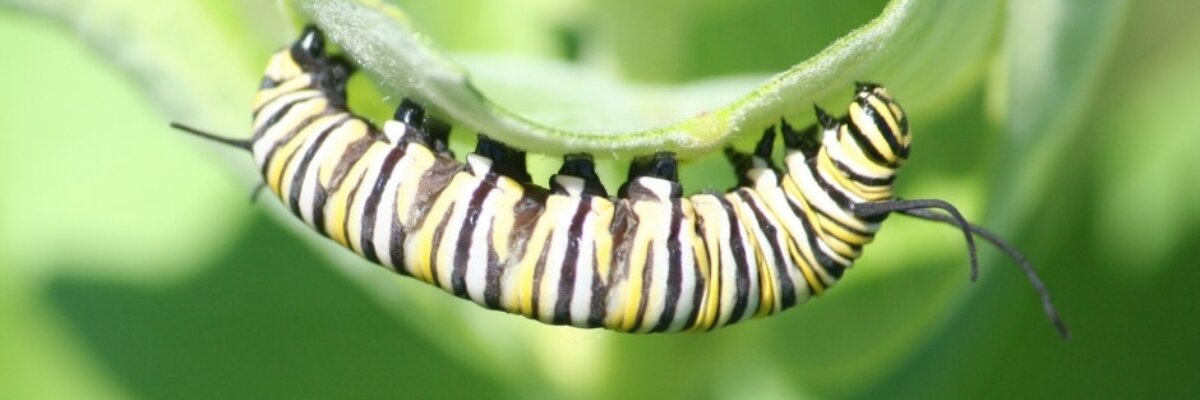
Predation
- What are some reasons a caterpillar might die?
There many reasons why a caterpillar might not survive to adulthood. It can be very difficult to determine exactly what happened to a particular larva, but these are some of the reasons one may die.
There are many diseases and parasites that affect monarchs. Infection can be transmitted between adults and/or larvae, especially if the monarchs are in close proximity. For more information on the risks of rearing monarchs in close proximity to one another, see our handout: Rearing Monarchs For Research: A Guide for Enthusiasts
The genetics of each monarch can also determine the outcome of each monarch, some may have a genetic reason they did not survive.
The contamination of milkweed can also reduce the odds of monarch larvae successfully making it to and survive adulthood. If the milkweed the larvae ingest carries pesticides, bacteria, or other harmful organisms, this may also be a reason monarchs might not survive.
Monarchs also have many predators that are part of their natural ecosystem.
- Should I kill insects or other predators that I suspect are killing the monarchs in my garden? Is there a way to prevent predation from happening that will not harm the monarchs?
Predation is a normal part of the monarch life cycle. Killing insects or other predators that you suspect are harming the monarchs in your garden is not encouraged. Instead, participating in community science programs such as Project Monarch Health and the Monarch Larva Monitoring Project will allow you to contribute data on what’s going on in your habitat to monarch conservation. Even though it may be difficult to see monarchs die, knowing what caused their demise is extremely beneficial to understanding the survival rates of monarch. It also helps gain insight into the overall health of the monarch population. Community science data collected through these and other programs have resulted in new discoveries about monarchs and the pressures they face.
- How are monarchs toxic to predators?
Monarchs become toxic to predators by sequestering or storing toxins from the milkweed plants that they eat. Milkweed contains toxins called cardenolides, or cardiac glycosides, which are toxic to predators. This makes monarchs very distasteful or unpleasant to predators. Some predators have evolved ways to avoid or tolerate these toxins, such as the bird predators found in the Mexican overwintering colonies.
- What invertebrate predators do monarchs have?
Invertebrate predators such as ants, spiders, and wasps attack monarch larvae on milkweed plants. Wasps have been observed feeding on monarch abdomens at a California overwintering site, and fire ants have been suggested as a major predator of monarch larvae in Texas. Other research suggests that wasp predators may be sensitive to the chemical defenses of monarch larvae, and that wasps fed monarch larvae with high cardenolide concentrations had lower reproductive potential and more deformities in their nests than wasps that preyed upon less toxic caterpillars. Some invertebrate predators, such as ladybug larvae or lacewing larvae prey on monarch eggs.
- Are there monarch predators in Mexico?
Yes, there are two bird species that can eat monarchs in overwintering sites in Mexico. They are the black-headed grosbeak and the black-backed oriole. There are also about 5 species of mice that prey on the monarchs on the ground.
- Are milkweed bugs harmful to monarchs?
If you've ever looked closely at your garden, you've most likely noticed a wide variety of insects. Large and small milkweed bugs are very common in milkweed patches and can sometimes be found on monarch larvae and pupae. Large milkweed bugs are herbivorous - they feed on the leaves, stems, and seeds of milkweed using their long proboscis. Because large milkweed bugs only eat milkweed, they should not be a problem for monarchs. Small (common) milkweed bugs are mostly herbivorous, but can occasionally be scavengers. These insects have been reported feeding on a wide variety of other insects, such as honey bees, monarch caterpillars and pupae, and dogbane beetles. While it may be disappointing to see monarch eggs, larvae or pupae preyed upon, this is all part of a vibrant milkweed ecosystem. Try not to kill the small milkweed bugs you find in your garden, their presence in the ecosystem is important!
- Why am I not seeing monarch caterpillars at my site?
If it's monarch season and you're not seeing monarchs at your site, there are a few things that could be happening. Monarch larvae have natural predators that may be getting them before you can spot them. Learn about monarch natural predators here.
It's also possible that adult monarchs aren't laying any eggs at your site. If this is the case, you can work to create a more diverse and extensive garden with more milkweed plants. The more milkweed you have at your site, the more likely it is that you'll find eggs and larvae! For more information on creating monarch habitat, check out the MJV 'Create Habitat for Monarchs' page.
- Why are caterpillars disappearing from my milkweed patch?
There are a number of potential reasons for this. If disappearing caterpillars are 5th instar caterpillars, odds are they moved away from your milkweeds to find a safe place to form their chrysalis (they typically do not pupate on milkweed plants). If earlier instars or eggs are disappearing, a more likely culprit is a monarch predator. You can read more about natural enemies on our website. Researchers agree that less than 10% (with some studies as low as 2%) of monarch eggs reach adulthood.
- Are there natural predators that kill monarch eggs, larvae, and adults?
Yes, the percentage of monarchs that survive from egg to adulthood is very low. Researchers agree that less than 10% of the eggs that are laid survive to become adult butterflies, and some feel that this number may be significantly under 10%. To account for low survival in the wild, female monarchs can lay 300-500 eggs in their lifetime.
